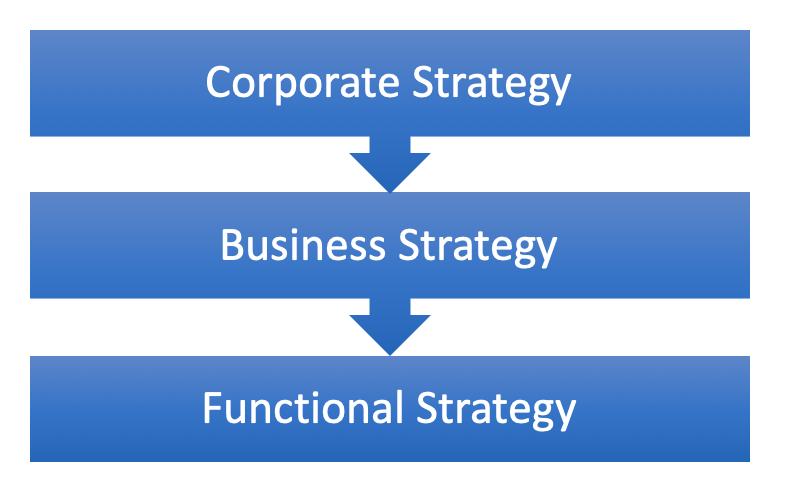
An organizational strategy is a plan over a defined duration that includes a set of actions that a company will undertake to accomplish its goals.
These actions may include aspects such as:
- How it will use it’s resources (inc people and materials)
- Which capabilities it will utilize or develop
- Which markets it will operate in
- How it will attract customers
- How it will optimize its people & structure
- Setting financial targets
Organizational strategy is seen as a key business enabler, one that provides a clear roadmap to achieve success.
In this article covering organizational strategy, we’ll be looking at:
- What is an Organizational Strategy
- Organizational Strategy Hierarchy
- Examples of Organizational Strategy
- How to deploy an organizational strategy
- What makes an organizational strategy effective?
- The role of Human Resources in strategy
- Measuring the effectiveness of an organizational strategy
- Changing your organizational strategy
- Benefits of Organizational Strategy
- Issues with Organizational Strategy
What is an Organizational strategy?
As we discussed in our introduction, an organizational strategy is a plan that includes a set of actions that a company will undertake in order to accomplish goals.
Let’s have a look at the inputs into the organizational strategy:
- Vision statement – Where your organization will be when it has achieved its mission. i.e., “to enhance people’s lives through the use of technology.”
- Mission statement – The organization’s mission statement documents why the business exists and what it intends to do. i.e., “ABC inc exists to be the number one PC reseller in the USA.”
- Goals – A set of goals that help an organization achieve its mission; typically, this will include the use of SMART goals and objectives.
- A plan – Including steps & stages required to achieve goals.
- Business structure – Describing how resources and the wider organization will be utilized.
- Capabilities – Describing what the business can ‘do’ and how they relate to its goals. For example, “strong relationships with PC manufacturers,” “excellent customer support”)
- Duration – A strategy will usually be of a fixed duration (i.e., a strategy for the next 12 months). Organization strategies can be either short, medium, or long term.
- Limited – An organizational strategy is not open-ended. It will have a specified objective upon which time it will be reviewed and updated. Organizational strategy is not fixed.
Organizational Strategy Hierarchy
An organizational strategy consists of a hierarchy of strategies:

1/ Corporate Strategy
The corporate level strategy articulates the primary purpose of an enterprise, establishing the destination it is trying to reach.
Common corporate strategies include:
- Increasing market share
- Increasing profit
- Diversification of product
- Sale of business
- Turnaround from poor performance to great performance
At this level, most strategies are likely to be
- Broad in concept
- Complex to complete
- Require appropriate business and functional strategies
Think of this as the strategy for ABC Inc who has multiple business units and operates globally.
2/ Business Strategy
Business Strategy is a bridge between corporate strategy and functional strategy.
It has a greater focus than corporate strategy, for example:
- Your corporate strategy may be to increase market share; your corresponding business strategy may be:
- Develop marketing budget.
- Increase distribution channels
- Review pricing
- Develop new products.
Think of this as Florida business unit strategy within ABC Inc.
3/ Functional Strategy
Functional level strategies relate to actions and targets for departments (i.e., Supply Chain) that follow business and corporate strategy (i.e., how can the Floriday supply chain team help the Florida business unit be more profitable.)
Functional strategies focus on driving lower-level actions that support business and corporate level goals. E.g., “The Florida supply chain function has the goal of negotiating improved contracts to help the Florida business units achieve greater profitability so that the corporate goal of having more net cash is achieved.”
Examples of Organizational Strategy
There are a number of models and methodologies that can be utilized when developing organizational strategies:
- Porters generic business strategies: – Four business strategies that can be utilized in order to obtain competitive advantage developed by US Academic Michael Porter, these are:
- Cost Leadership
- Differentiation
- Cost Focus
- Focus Differentiation
- Growth – Focusing on expanding your business
- Acquisition – Focusing on acquiring other businesses to achieve goals.
- Structuralist – Where Strategic options are bound by the current organizational structure and capability
- Price-Skimming – A strategy where an organization charges an initial premium or high price then, over time, lowers it.
- Rationalization – Improving efficiency through reorganization of the business.
- Functional strategy – focusing on short term goals for specific functional areas within the business.
- International – Goals that help an organization spread its trade internationally.
How to deploy an organizational strategy
Once you’ve recognized the need for strategy, the next question is, how do you build and deploy it?
In simple terms by:
- Analyzing the industry the business operates within
- Evaluating competition through assessing strengths and weaknesses
- Establishing a strategy with the intent of outperforming the competition.
Developing a strategy usually takes a series of steps.
- Create a Vision.
- Define short-term and long term goals
- Define your priorities (i.e., Devise a new phone product)
- Devise your targets and goals for each priority (i.e., hardware/software readiness)
- Devise your timing plan
- How long is the plan
- What will you do in year/month 1?
- What will you do in year/month 2?
- etc
- Identify:
- Sponsors for each Priority.
- Leaders for Each goal they will.
- Delivery teams to deliver the goal.
- Resources required to deliver.
- Launch projects to deliver goals and priorities
- Review and assess
What makes an organizational strategy effective?
For any business strategy to be successful, it must have a number of characteristics:
- The vision must make sense
- The goals must be realistic
- The timeframe must be realistic (which doesn’t mean it can’t be challenging)
- The business must look at enabling success through resource provision, enabling people with the right tools/processes, etc.
- It must foster innovation
- Your plan must be build from short term goals that cascade to hit larger objectives
- It must be supported
- It must not be afraid of change
The role of Human Resources in strategy
The Human Resource function has a key role to play in the success of an organization’s strategy.
As we’ve discussed within this article, the talent within an organization is perhaps the definitive key enabler for its success (or not). Whether that’s through aspects such as:
- Bringing in the right talent
- Driving high employee retention
- Learning & Development
- Managing change
The importance of HR within strategy can be underpinned by several broad concepts.
1/ HR helps a business define and maintain its values
2/ HR helps a business express its culture.
3/ HR fuels the “people” demand of strategy.
4/ HR facilitates change through ‘people components’ within the enterprise
5/ HR equips the organization through its core processes
Measuring the effectiveness of an organizational strategy
Fundamentally, you could argue that if you’ve met your goals, then you’ve been effective; however, there are several more granular views that help us measure the effectiveness of strategy:
- Own expectations (e.g., if your goal was to introduce new products, you could count the number of products pre and post strategy)
- Financial success
- Profitability
- Revenue & Revenue Growth
- Revenue streams
- Market share
- Customer perception
- Performance reviews of staff
- Resource use
Changing your organizational strategy
Organizational strategy is not fixed and should be reviewed and adapted along the way.
Strategic change is a methodology in its own right, but you should be aware of its existence and plan how you will review your business strategy regularly to ensure it’s effectiveness.
There are a number of key drivers for change, which include;
- Your strategy isn’t effective in delivering your goals
- Competitors drive change
- Legislation requires change
- Innovation drives change
- Another event – e.g., the COVID pandemic of 2019 required many businesses to assess their organizational strategy and develop plans to counter its impact.
Benefits of Organizational Strategy
So how do we sum up the benefits of strategy?
Strategy:
- Establishes an aspirational vision of the future
- Sets priorities
- Aligns everyone to common goals
- Establishes values
- Helps with decision making
- Determines the process we will use to leverage strengths.
- Establishes boundaries
- Helps assess and mitigate risk
Issues with Organizational Strategy
Some common issues with strategy include:
- Poor understanding of organization capabilities and, therefore, what you can /cannot achieve.
- Poor understanding regarding markets and customers and therefore making the wrong decisions
- Unable to execute strategy due to lack of investment (i.e., resources, etc.)
- Failure to track progress and react accordingly
- Failure to develop human capital
- Goals/Objects too complex to complete within the timescale.
- Poor project control/planning
- Capabilities do not exist to reach goals.
- Failure to adapt or change strategy in line with market forces
Summary
Fundamentally organizational strategy contributes significantly to making an organization a success.
From the big picture view to functional tasking, if the business selects the right activities to improve itself, it’s likely to see some gains there is sufficient contribution from the businesses resources.
However, any strategy is prone to failure if the organization fails to follow up on its objectives, ensuring that resources get allocated, capabilities developed, and markets understood.
What are your thoughts on strategy? Have you seen a business excel through a strong and effective strategy? Perhaps you’ve seen the opposite, and you have some learning to share?
You can reach us on Twitter (@sanbustrain) or via the comments below.
This article is part of our Human Resources Guide.